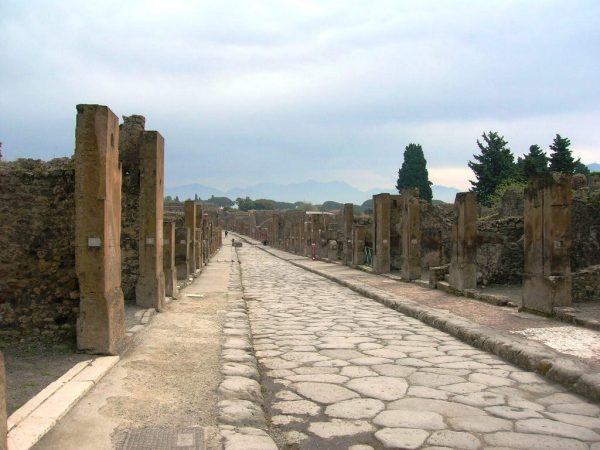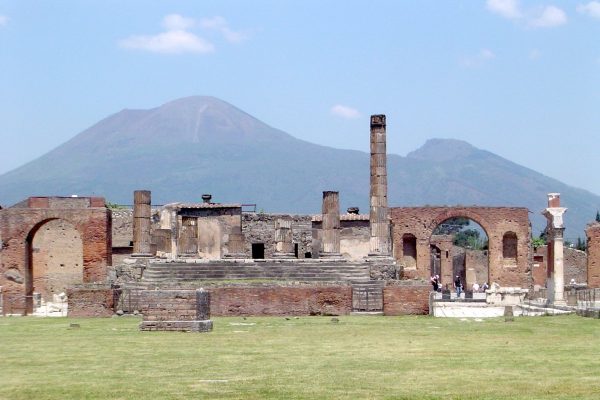Newly Excavated Section Of Pompeii Can Be Visited Via Drone Footage
Thanks to the completion of a fifty-four-acre excavation at Italy’s Pompeii Archaeological Park in the shade of Mt. Vesuvius, a new section of the ancient city has been revealed and can be seen by everyone who has access to YouTube.
Park Director Massimo Osanna hosts the video he and his colleagues took using a drone and shows us an aerial view of Regio V, a section previously used as a dumping area that now shows some of the most magnificent wall frescoes and mosaics ever seen in Pompeii.
Two specific homes are highlighted, not because they were grand and rich, but to show how the middle class of Pompeii lived.
The video shows the Garden House, a medium-sized home with a garden attached that shows enough of an outline as to how it was laid out and what type of plants grew there that Osanna believes it can be accurately recreated.
The house had many small rooms, some with nicely preserved frescos on the walls. Amphorae, terra cotta jugs that held olive oil, fish sauce, and wine, were stacked in the corner of a room, still in surprisingly good shape.
Sadly, eleven bodies were found in one room of the residence, mostly women and children, where they were most likely hiding from the chaos.
A neighbor of the Garden House, the Orion House, has two-story mosaics that have scenes from the Greek mythological story of how Orion, the rather promiscuous son of a Greek god, was turned into a constellation.
One room has a mosaic of stars in the sky marking the Orion constellation and the other room shows a mosaic of Orion being eaten by a scorpion until, when given wings by Jupiter, he metamorphosed into a constellation up in the sky.

Other beautiful frescoes found include Leda and the Swan as well as satyrs and nymphs associated with the cult of Dionysus and one of Narcissus checking his reflection in a pool of water.
In 79 AD, Mount Vesuvius roared to life and destroyed all of the surrounding communities of Herculaneum, Oplontis, Stabiae, and Pompeii with pyroclastic flows, volcanic ash and rocks, and lava.
The sites were left relatively undisturbed for over a thousand years. But was Pompeii actually forgotten?
According to Khan Academy, several tunnels were dug during a possible rescue operation soon after everything cooled down, and some of the taller buildings still stuck up through the volcanic material for some time.
By the middle ages, people still knew something was there as they called it La Cività – the settlement.
The first person known to get a glimpse of the underground city was architect Domenico Fontana who, in about 1600, was overseeing construction for a canal in the area and came upon frescos and architectural blocks, but he had no interest in following up to see what else was there.
In 1748, Pompeii was rediscovered and Rocque Joaquin de Alcubierre, a military engineer, was selected to begin excavations in Pompeii after having begun the work of excavating Herculaneum in 1738.

With all of the artifacts coming out of the excavations, King Charles of Naples and Sicily initiated a Royal Academy in Naples in 1755 in order to catalog the sites and the discoveries before he took them for his personal use.
In 1780, Francesco la Vega came to Pompeii as director of excavations and began working on the preservation and stabilization of the buildings. In 1863, Giuseppe Fiorelli took charge and was the one who poured plaster into the voids in the ash where bodies had once been to recreate the last moments of life in Pompeii.
According to Smithsonian Magazine, Pompeii has been an archaeological site for over two hundred years, but one-third of the area has not yet been excavated.
‘Like finding a new planet’ Shipwrecks Found Dating From 300 BC
Because weather and tourists are causing rapid deterioration to the town, many Roman experts believe the focus should be set on preserving what has already been uncovered and leaving the rest for future archaeologists to find.





